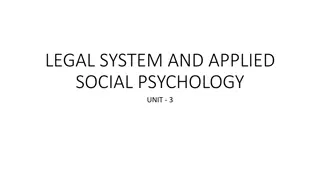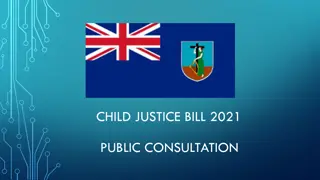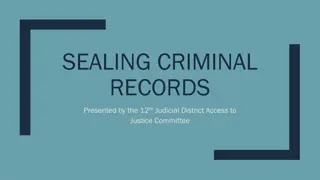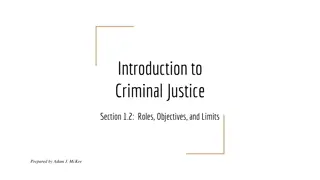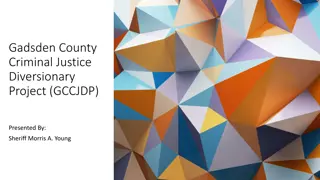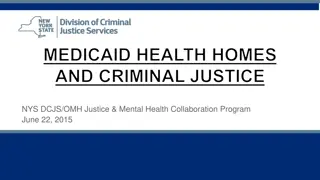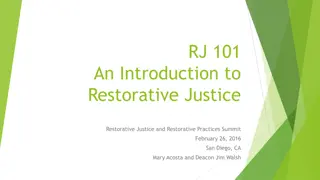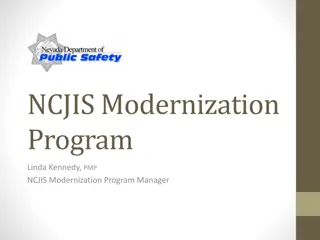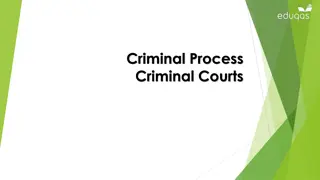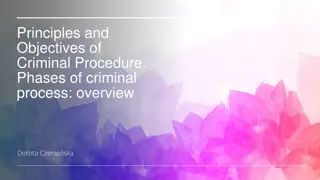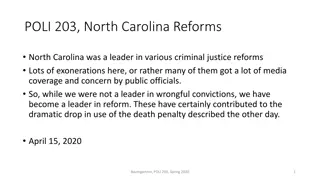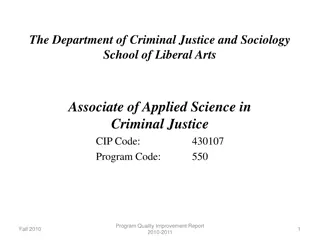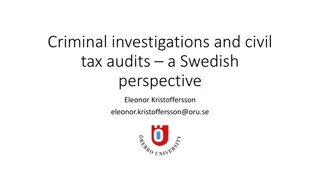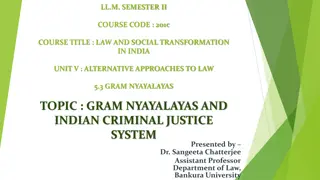Overview of Criminal Justice System Components in the United States
The criminal justice system in the United States comprises various systems at state and federal levels. It consists of major components - Police, Courts, Corrections - bound by the Rule of Law and the Constitution. The Courts interpret laws and uphold civil liberties, with remedies available for violations. Citizens can seek redress under Section 1983 of the United States Code. The role of law enforcement, including police officers and federal agents, is pivotal in upholding justice.
Download Presentation

Please find below an Image/Link to download the presentation.
The content on the website is provided AS IS for your information and personal use only. It may not be sold, licensed, or shared on other websites without obtaining consent from the author.If you encounter any issues during the download, it is possible that the publisher has removed the file from their server.
You are allowed to download the files provided on this website for personal or commercial use, subject to the condition that they are used lawfully. All files are the property of their respective owners.
The content on the website is provided AS IS for your information and personal use only. It may not be sold, licensed, or shared on other websites without obtaining consent from the author.
E N D
Presentation Transcript
Introduction to Criminal Justice Section 1.1: Major Components Prepared By Adam J. McKee
The System? In reality, there is no one criminal justice system in the United States. There are many similar systems. Each state has its criminal justice system, and the Federal government has another still. This section considers how these various systems are composed by looking at the major components common to them all. 2
Traditional Divisions Traditionally, the criminal justice system can be divided into three major components: 1. Police 2. Courts 3. Corrections 3
The Rule of Law It may seem that there is no real common thread to this system. In the United States, the thing that binds all of the components together and regulates them is the Rule of Law. The rule of law is the idea that every person is subject to the law, even those that make the law, interpret the law, and enforce the law. 4
The Constitution The most potent law in the United States is the Constitution of the United States. This body of laws provides all Americans with civil liberties that the government cannot violate. If a state law or a federal law violates any of these protections, then the law will be declared void. 5
The Role of the Courts It is up to the appellate courts, most notably the Supreme Court, to interpret these laws and determine the exact nature and scope of specific civil liberties in the United States. Further, if an agent of the state or federal government violates a person's rights, that person has remedies available. 6
Remedies Citizens can sue government employees that violate their rights under Section 1983 of the United States Code. An important remedy in criminal justice is the exclusionary rule. The exclusionary rule was established by the Supreme Court (SCOTUS) to prevent police misconduct. The rule states that illegally obtained evidence (evidence obtained in violation of someone's constitutional rights) cannot be admitted as evidence in court. 7
Police People tend to use the word police generically to indicate those individuals with law enforcement responsibility. The majority of these are municipal police officers. There are many sheriffs deputies as well as state and federal agents that do not technically fit under the umbrella term police. 8
Police Functions Enforcing the law is only a small fraction of what the police do every day. They maintain order and provide many services to the communities they serve. The police also have the responsibility of investigating crimes, collecting evidence, and work with prosecutors to obtain convictions in court. 9
The Gatekeepers The police are often called the gatekeepers of the criminal justice system. This description is accurate because entry into the system requires formal action on the part of law enforcement. Police officers have incredible decision-making authority when dealing with citizens and suspects. An officer can choose to ignore an offense, issue a verbal warning, issue a written warning, issue a citation, or formally arrest the person. 10
Limits on Discretion Of course, the seriousness of the crime plays a major role in how the police exercise discretion. An officer would not ignore or issue a citation to a person engaged in a serious felony crime. 11
Specialization in Policing The duties of police officers can be very general in the case of a patrol officer, or they can be very specialized in the case of a homicide detective. The level of specialization depends largely on the size of the agency where the officer works. Large, urban police departments tend to have more resources, more officers, and a higher degree of specialization. 12
The Backbone of Policing The backbone of policing is the patrol division, and patrol is always a generalist function. The successful patrol officer is a jack-of-all-trades. 13
Courts When law enforcement and prosecutors accuse a person of violating a criminal law, it is up to the courts to determine if the person did indeed violate the law. If so, it is up to the court prescribe the appropriate punishment. Sentencing is limited by the sentencing laws in that court's jurisdiction. 14
Our Adversarial System Because the American legal system is adversarial in nature, there must always be two teams in any court case. In a criminal matter, a lawyer known as the prosecutor presents the government's case. A major goal of the prosecutor is to see the defendant found guilty of the alleged crime. 15
The Defense The defense attorney has the job of trying to show that the defendant is not guilty. The judge serves as a referee, making sure that both sides diligently follow the rules of the "game." The jury is tasked with deciding (at the end) who the winner is. In the adult criminal justice system, all cases are adversarial in nature. 16
Finders of Fact In a jury trial, the jury serves as the finder of fact. The term finder of fact in this case means that the jury decides whether the defendant is innocent or guilty. In serious cases, the defendant has a right to trial by jury. It is allowable, however, that the defendant consent to a bench trial. A bench trial is a trial where the judge takes on the role of the jury as finder of fact. 17
Corrections Corrections is another umbrella term that encompasses many diverse criminal justice activities. Corrections can include: probation parole jail prison many community-based sanctions 18
What is it for? A problem with accurately defining corrections is a general disagreement about the philosophy of incarceration. Does society send people to prison as punishment, or for punishment? Do we expect prisons to punish or rehabilitate? Most people can agree on one thing: The public expects correctional institutions to ensure the public safety. 19
Jails Jails are usually operated at the local level, most often under the leadership of a county sheriff. Jails are most commonly thought of as holding individuals that have been arrested and are awaiting a first appearance in court. Other jail inmates have been convicted of relatively minor offenses (misdemeanors) and are serving sentences of less than one year. Other prisoners may have been convicted of serious offenses, and are housed in the local jail awaiting transfer to a state prison. 20
Prisons Persons convicted of serious crimes can be sentenced to a prison term. A prison is generally larger, more secure, and provides more services than a jail. The reason for these extra services is that prisons are designed for long sentences (relative to jail sentences). Prisons are most often run at the state level of government, but there are also many federal prisons. 21
Defining Justice One of the overarching goals that brings the components of the criminal justice system together is that each is designed (in some way) to promote justice. Everyone has an idea of what justice is, but pinning down a definition that will be widely agreed upon proves to be a challenge. There are several different ways of looking at the idea. 22
Justice as Equality One way to view justice is in terms of equality. In economic language, equality means that everyone gets the same amount, regardless of what they "put in." 23
Justice as Equity Another perspective is to view justice in terms of equity. When viewed this way, it means that people get what they deserve. Many feel that "just deserts" means that criminal punishments should be in proportion to the harm done. This concept of just deserts in criminal justice has been referred to as retributive justice. 24
Lex Talionis The idea of wrongdoers being deserving of repayment in kind is known by the Latin phrase Lex Talionis, or the law of retribution. In its purest form, lex talionis is the Biblical doctrine of "an eye for an eye, a tooth for a tooth." In today's criminal justice system, the idea of retribution takes on the meaning of variable lengths of prison sentences. 25
Justice as Fair Process Another way to look at the idea of justice is to examine the process. In other words, an act is just if it was done using a fair process. Justice viewed in terms of fair process is often referred to as procedural justice. This idea leaves room for debate as to what sort of processes are to be considered fair. Accessibility and predictability are common criteria. 26
Due Process In the United States, the idea of procedural justice is closely tied to the idea of due process. In a philosophical sense, due process means that agents of the criminal justice system conduct criminal proceedings in a "fundamentally fair" way. In a practical sense, due process means that the state must respect all legal rights of accused persons. 27
Due Process and the Constitution What criminal justice procedures are required under due process is a dynamic body of rules. These rules are most often judicial determinations of what exactly the Constitution means in practice. The idea of due process is represented throughout the Bill of Rights, as well as being specifically guaranteed by the 1. Fifth Amendment (applies to the federal government) 2. Fourteenth Amendment (applies to state government) 28



